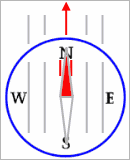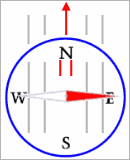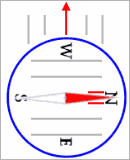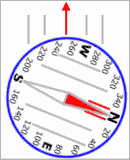No matter the compass, one end of the needle always points North. On our mountaineering compasses, it is almost always the RED end, but its a good idea to test your compass before starting to use it.
If you are north of the equator, stand facing the sun around lunchtime. Whichever end of the needle points towards the sun is South and the end that points at you is North.
If you're 'down under' the North end points towards the sun and the South end points at you.
If you are north of the equator, stand facing the sun around lunchtime. Whichever end of the needle points towards the sun is South and the end that points at you is North.
If you're 'down under' the North end points towards the sun and the South end points at you.
To read your compass,
- Hold your compass steadily in your hand so the baseplate is level and the direction-of-travel arrow is pointing straight away from you.
- Hold it about halfway between your face and waist in a comfortable arm position with your elbow bent and compass held close to your stomache.
- Look down at the compass and see where the needle points.
This compass is pointing due North (also 0 degrees) 
- Turn your body while keeping the compass right in front of you.
- Notice that as the compass rotates, the needle stays pointing the same direction.
- Keep turning until the needle points East like the picture below, keeping the direction-of-travel arrow and North mark facing straight in front of you.
This compass is pointing East (90 degrees) 
- Important: This is a very common mistake! The compass needle is pointing towards East so I must be pointing East, right? No, no, no!
To find my direction, I must turn the compass dial until the North mark and the "Orienting Arrow" are lined up with the North end of the needle. Then I can read the heading that is at the Index Pointer spot (the butt of the direction-of-travel arrow).
Since the Orienting Arrow is usually two parallel lines on the floor of the compass housing, a good thing to memorize is:RED IN THE SHED Now we know we are really heading West (270 degrees) 
Take a Bearing
By simply moving your compass with your body and using the N-E-S-W markings, you can get a good idea which way you are going. This is often all you need from your compass. But, you've probably noticed on your compass, there are also numbers and tiny lines. These represent the 360 degrees in a circle that surrounds you no matter where you are. 

When you need to find your way from one particular place to another, you need to use these numbers to find out the bearing to that remote place. The direction you are going is called your heading. Heading and Bearing are pretty much the same thing. The image above is a heading of about 250 degress.
Using your compass, take a few bearings. Move your body until the direction-of-travel arrow points at the following items and then turn the dial until "RED is in the Shed". Then, read the bearing at the Index Pointer:
- You computer screen: ____________ degrees
- Your window: ____________ degrees
- Your door: ____________ degrees
- A lightswitch: ____________ degrees
Compass Reading Tips
Hold the compass level - if the compass is tilted, the needle will touch the clear lid and not move correctly.
- Read the correct end of the needle.
- Use common sense, such as knowing that if you are heading anywhere towards the sun, there's no way you can be heading north, northwest, or northeast.
- RED IN THE SHED!
- Keep the compass away from metal objects - even a knife, flashlight, or keychain can cause a false reading if too close to the compass.

No comments:
Post a Comment